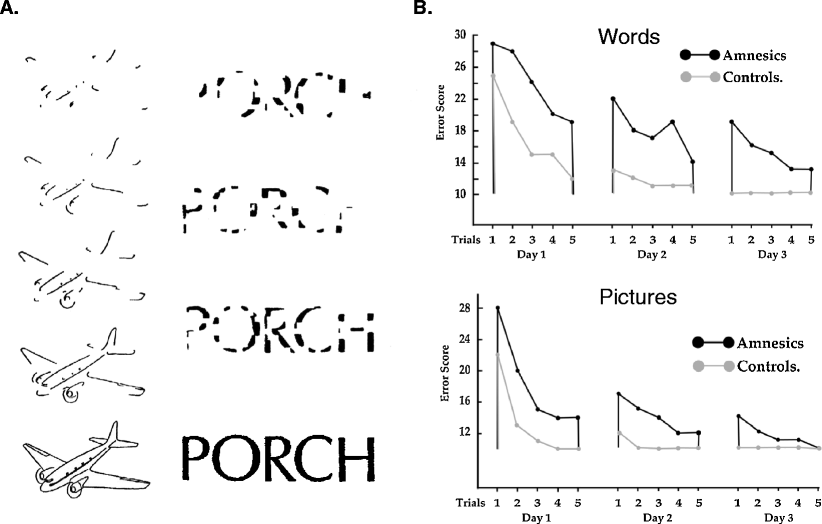Familiarity vs. Context Recollection in Amnesia
Mandler (1980) suggested that familiarity and recollection Opens in new window represent two alternative routes to recognition. An item may be judged familiar when we feel we have seen it before, without necessarily remembering where or when.
Recollection involves remembering the actual occasion in which the item was encountered. Recollection therefore involves the retrieval of context, whereas a familiarity judgment does not.
Mandler argued that a familiarity judgment was an automatic process, which occurred without conscious effort or volition. Recollection on the other hand was considered to be a controlled process, which requires conscious effort and is carried out deliberately.
A number of studies have suggested that organic amnesic patients Opens in new window retain the ability to detect the familiarity of a previously encountered item but have particular difficulty recollecting the context from which it is familiar.
Huppert and Piercy (1976) performed a classic experiment demonstrating the poor context retrieval of amnesics. They showed Korsakoff and control subjects two sets of pictures, the first set being shown on day 1 of the experiment and the second set on day 2.
Shortly after the presentation of the second set, the subjects were tested for their ability to recognize the pictures they had been shown, by picking them out from a mixture of previously presented pictures and new ones that had not been previously presented.
 Figure X-1 | Focus on B. The recognition of pictures and discrimination of presentation context in Korsakoff amnesics and normal controls.
Figure X-1 | Focus on B. The recognition of pictures and discrimination of presentation context in Korsakoff amnesics and normal controls.
As Figure X-1 “B” shows, both the amnesics and the normal control subjects proved to be very good at identifying the pictures they had seen before.
However, when asked to discriminate the pictures shown on day 2 from those shown on day 1, the performance of the amnesics fell to little more than chance level, whilst the control subjects still achieved a high level of accuracy.
Most of us would have little difficulty in distinguishing between something we saw yesterday and something we saw today, but contextual judgments of this type seem to be particularly difficult for amnesics Opens in new window.
Huppert and Piercy (1978) carried out a follow-up experiment which showed that the recognition performance of the Korsakoff patients was mainly based on a judgment of the general familiarity of the pictures.
The experiment was basically similar to their previous one, except that this time some of the pictures presented on day 1 were presented three times, in order to increase the strength of their familiarity.
When requested on day 2 to pick out the recently presented (day 2) pictures, the amnesic subjects often chose pictures which had been presented three times on day 1, and in fact were just as likely to pick them as they were to pick out pictures presented once only on day 2.
These results suggest that Korsakoff patients respond to a recognition test by making a judgment of the general familiarity of a test item, without knowing whether that familiarity arose from frequent presentation or from recent presentation.
One method of distinguishing familiarity-based responses from context recollection is the process dissociation procedure Opens in new window (Jacoby et al., 1993). This procedure makes use of inclusion and exclusion tests, the former reflecting a conscious recollection of context and the latter an automatic familiarity judgment.
Using this procedure, Verfaellie and Treadwell (1993) confirmed the earlier findings that amnesics were largely restricted to familiarity-based recognition responses and were unable to recollect context.
Parkin et al. (1990a) devised a test of recency judgment in which subjects were shown four pictures which they had to pick out from an array of sixteen pictures presented one minute later.
However, in subsequent trials the pictures which had originally been presented as distracters were now used as targets, whilst target items now became distracters.
All the pictures thus became familiar to the subjects, so that in subsequent trials the subjects were only able to identify the target items by recalling the recency of their presentation. The procedure therefore tested the judgment of temporal context.
Parkin et al. administered this test to both Korsakoff Opens in new window and HSE Opens in new window patients, and they found a severe impairment of recency judgments in the Korsakoff patients but relatively little impairment in the HSE patients.
On the basis of these findings, Parking et al. concluded that context retrieval seemed to be particularly difficult for Korsakoff patients (who have diencephalic lesions), but not for HSE patients (who have temporal lesions).
Further support for this view came from a study by Hunkin et al. (1994), using the list discrimination procedure, in which subjects are presented with two lists of sentences separated by a filled three-minute interval.
Whilst Korsakoff and HSE amnesics obtained similar scores for correctly recognizing target sentences, the Korsakoff group were far worse than the HSE group at discriminating between list 1 and 2 sentences.
In view of these findings, Parkin (1996) drew the tentative conclusion that the impairment of context retrieval may be specifically associated with diencephalic lesions, noting that most previous reports of impaired context retrieval had in fact involved Korsakoff subjects.
See also:
- David Groome, Hazel Dewart, An Introduction to Cognitive Psychology: Processes and Disorders (p. 151) "Memory Functions Preserved in Amnesia"

